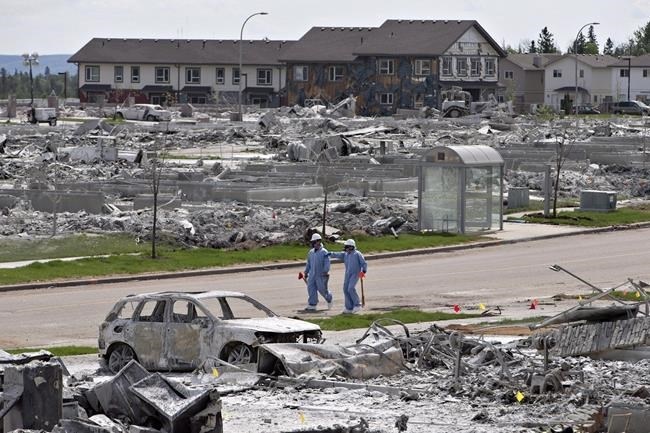
Workers put out markers around a devastated area of Timberlea in Fort McMurray Alta, on Thursday, June 2, 2016. The Insurance Bureau of Canada says damage caused by the wildfires in Fort McMurray, Alta., totalled $3.58 billion, making it the most expensive disaster for insurers in the country's history.
Image Credit: THE CANADIAN PRESS/Jason Franson
July 08, 2016 - 7:00 AM
CALGARY - The wildfire that rendered the heart of oilsands country a charred and ashy mess is estimated to be the costliest disaster in Canada, worrying evidence that extreme weather events have increased in frequency and severity, the Insurance Bureau of Canada said Thursday.
About $3.58 billion in damage is expected due to the fire in May that swept through Fort McMurray, Alta., nearly twice as much as the January 1998 ice storms that paralyzed eastern Ontario and southern Quebec. That disaster resulted in just over $2 billion in damages when converted into 2015 dollars, the bureau said.
"Ultimately what we are seeing is that our climate is changing, and the long-term trends are directly a result of some of those dynamics," Bill Adams, Western and Pacific vice-president for the bureau, said on a conference call.
Adams urged various levels of government to design building codes and land use policies that "keep people out of harm's way" by anticipating fires, floods and other disasters. Specifically, he said people should stop building houses in flood plains and putting flammable cedar shingles on homes in the middle of forests.
"Historically, we have not done that well in Canada and perhaps less so in Alberta," he said. "Unfortunately, we're living with the consequences."
Last week, Fort McMurray fire Chief Darby Allen issued a similar call for less flammable home construction materials and a bigger buffer zone between the city and the forest. In response, Melissa Blake, the mayor of the Wood Buffalo Regional Municipality that encompasses Fort McMurray, said she thinks change may come through personal choices rather than new bylaws or building codes.
In an audit published in May, Julie Gelfand, the federal environment and sustainable development commissioner, recommended that the National Building Code be updated to take into account increasingly frequent severe weather events stemming from climate change.
The Fort McMurray fire forced almost 90,000 residents from their homes. It destroyed about 1,800 houses as well as buildings containing about 600 apartments or condo units. People have since been allowed back into the community, but it took nearly two months before a state of emergency could be lifted.
Adams said most of the damage from the wildfires will be covered by insurance. That was not the case during the June 2013 floods in southern Alberta, where total damage came to about $6 billion but most of that was caused by overland flooding for which most people did not have insurance coverage, he said. In the end, nearly $1.8 billion in damage claims were made when expressed in 2015 dollars.
The tally of the damage in Fort McMurray is based on surveys of insurance companies by Catastrophe Indices and Quantification Inc. Of the $3.58 billion in damage, about $2.2 billion is expected to be for personal property loss, it said.
About $1.25 billion in commercial claims and $180 million in auto insurance claims are also expected.
Managing director Carolyn Rennie of CatIQ said the commercial claims would also cover business interruptions. Financial analysts estimate that as much as 30 million barrels of oilsands production worth $1.6 billion was lost as producers were forced to shut down or curtail operations, although the fire did little physical damage to their projects.
Adams said the insurance industry will announce as early as next week a program to help remove debris from burned-out neighbourhoods, a similar initiative to the co-ordinated disposal of fridges and freezers tainted by rotting food as Fort McMurray residents returned to the city last month.
He said Alberta has been hit by seven of the 10 most expensive disasters in Canadian history and although no one event directly affects insurance rates, most Albertans are paying higher premiums.
"This wildfire is, yes, the largest," he said. "But unfortunately it's one in a series of significant events ... that have taken place in Alberta over the course of the last number of years, so I think most Albertans who have had renewals would have seen their premiums increase.
"What impact this will have will be determined at a later date by individual insurers."
Follow @HealingSlowly on Twitter.
News from © The Canadian Press, 2016